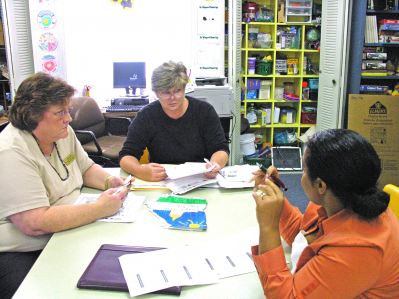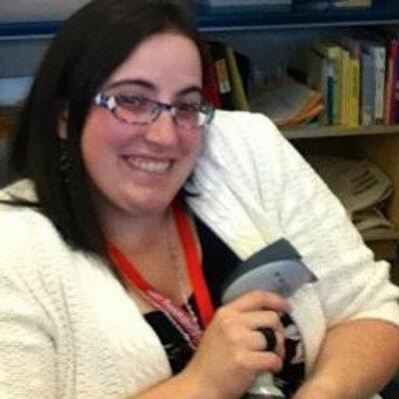Teaching for Learning: Collaborative Planning
Update December 2020:
This web page is a companion to the 2016 version of the School Library Program Rubric. NYSED released an updated School Library Program Rubric in December 2020.
Student Snapshot: Students are encouraged to become lifelong learners through the collaboration and coordination of the library media program with classrooms and the community.
According to New York City School Library System (2014), collaboration is two or more people working toward a common goal. In this case, the library teacher and the subject teacher meet, plan and execute one or more lessons or an entire unit. Research shows that collaboration between subject teacher and library teacher creates the basis for quality education and student achievement.
Source: New York Library System. “2.4 Collaborative Planning.” New York City Department of Education, 2014.
Citation for Photo: Baxter, Judy. Planning for "Best Practices” Video. 2006. Flickr.This web page features a photo from Judy Baxter, available under Creative Commons Attribution-NonCommercial-ShareAlike 2.0 Generic license.
In Practice
Collaborative Planning Tips for School Librarians
Description: A blog post that provides strategies on how school librarians and teachers can collaborate based on a New York State school librarian’s collaborative experiences.
Resource/Citation: Muhlbauer, Maria. “Collaborative Planning Tips for School Librarians.” Pioneer Middle School Library Happenings. Pioneer Middle School Library, 9 Feb. 2016.
Forms for Planning, Collaboration, and Documentation
Description: This web page includes documents and forms that are very useful when planning for libraries and collaboration with other stakeholders in the school community.
Resource/Citation: School Libraries Systems Association. "Forms for Planning, Collaboration, and Documentation." School Libraries Systems Association of New York, n.d.
High School LMS Collaboration Video
Description: This video features four vignettes that demonstrate key aspects of collaboration between teachers and library media specialists, including standards-based instruction and assessment. Each vignette showcases a different topic and includes a number of specific, thoughtful questions for educators to consider together.
Resource/Citation: “High School LMS Collaboration Video”. YouTube, uploaded by Bryan Class, 12 Feb. 2013.
Collaborative Planning Organizer
Description: This collaborative planning document is a useful tool for School library media specialists who are looking to connect the library's resources to their school’s curricula and instruction materials.
Resource/Citation: Kalmon, Stevan, and Nance Nassar. “Collaborative Planning Organizer”. Library Research Center, 2008.
Competitive Advantage
Description: This is a chapter from the book School Library Management that details the benefits and barriers to collaborations. It details the different facets of collaboration.
*Resource/Citation: Repman, Judi, and Gail K. Dickinson. "School Library Media Collaborations: Benefits and Barriers." School Library Management. 7th ed., Linworth, 2015.
The Competitive Advantage
Description: In today's struggle for recognition of the importance of school libraries, it is especially important to make it known that school libraries are essential components of education. In Henrico County (Virginia) Public School libraries, the American Association of School Librarian's National Library Program of the Year, school librarians have taken a leadership role in an innovative county-level program called Henrico 21 (H21). In this article, the author describes how the H21 competition inspired collaboration and leadership.
*Resource/Citation: Mabry, Lauren. "Competitive Advantage." Knowledge Quest, vol. 40, no. 3, 2012, pp. 66-71. ERIC.
Collaborative Planning: An Excerpt from Library Learning Walk
Description: Developed by the New York City Department of Education with information from Library Learning Walk, this comprehensive document provides collaborative planning ideas, lessons and resources. It also included a planning document that can be used.
Resource/Citation: New York Library System. “2.4 Collaborative Planning”. New York City Department of Education, 2014.
Raising the Bar
Description: The article discusses how Pine Grove Middle School's library program is engaging staff and students in a culture of participation. According to the author, Pine Grove Middle School uses a multifaceted approach to increase the level of engagement from all groups of stakeholders. The author adds that because of these active partnerships, Pine Grove Middle School's library program continues to expand its influence.
Resource/Citation: Kowalski, Sue. "Raising The Bar." Knowledge Quest, vol. 41, no. 1, 2012, pp. 28-36.
In Theory
Making the Classroom-Library Connection
Description: This report focuses on the outcomes of a workshop for 165 preservice student teachers. The objectives of the workshop were to encourage preservice student teachers to talk with their mentor teachers, librarians, and principals about working collaboratively with the teacher librarian and to seek instructional partnerships during their student teaching experience.
Resource/Citation: Moreillon, Judi. "Making the classroom-library connection." Teacher Librarian, vol. 43, no. 3, 2016, p. 8.
Coteaching and the Learning Commons: Building a Participatory School Culture
Description: This article describes strategies to foster co-teaching with library professionals, rather than focus on professional development centered upon solo educators.
Resource/Citation: Loertscher, David V., and Carol Koechlin. "Coteaching and the learning commons: building a participatory school culture." Teacher Librarian, vol. 43, no. 2, 2015, p. 12.
Three Heads are Better Than One
Description: Twenty-first-century standards progressively call for librarians to step in as instructional leaders, connecting educators and students to materials, methods, and technology across the curriculum. Students who once received differentiated instruction or reading intervention are overlooked or underserved. Where can teachers and reading specialists receive support to help close the achievement gap? Librarians to the rescue! Currently, school librarians are discovering yet another dynamic leadership and role: co-teacher with classroom teachers and reading specialists in the library learning commons. This article explores strategies for librarians to implement differentiated instruction in collaboration with classroom teachers and reading specialists using a coteaching model.
Resource/Citation: Parrot, Deborah J., and Karin J. Keith. "Three Heads Are Better Than One." Teacher Librarian, vol. 42, no. 5, 2015, pp. 12-18. ProQuest.
Consultant
Name: Heather Turner
Email: haturner@gmail.com
Bio: Teacher Librarian at Solvay Middle School and Central New York School Librarians co-president.
*To access restricted database articles or books speak with your school librarian or public librarian.







